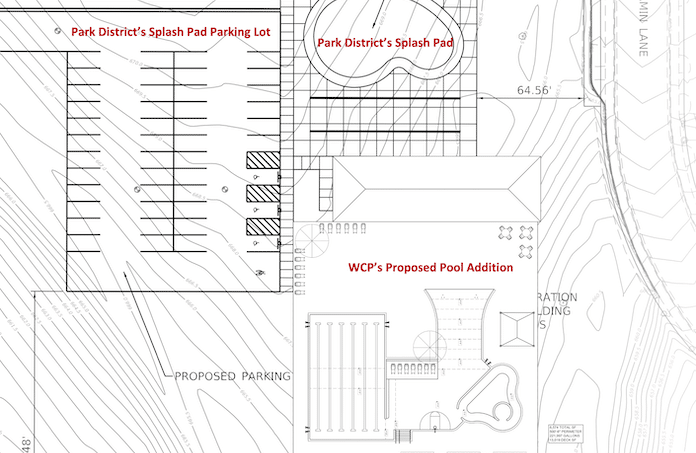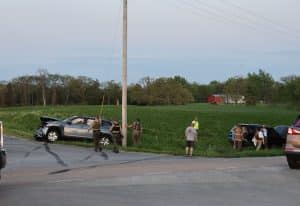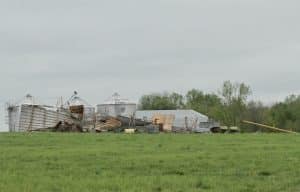Waterloo pool on horizon?

For several years now, Waterloo residents have heard about the possibility of a new pool – potentially paired with the impending splash pad project – coming to the community.
With the pool a current talking point in this year’s April 4 elections, many might be questioning what such a facility might look like and whether or not it could actually be realized in the near future.
As described in a presentation from the local organization Waterloo Citizens for a Pool which formed in 2017, the history of the Waterloo Park District is intrinsically tied to a city pool.
Back in the 1950s, several community members – accompanied by local organizations like the Optimist Club, Lions Club and Chamber of Commerce – pushed for creation of the park district.
The park district was eventually formed in 1955, with 40 acres of land now known as Konarcik Park donated in 1957.
Over a decade and three referendums later, the Waterloo Park District Swimming Pool officially opened in 1969, beginning a decades-long history involving a swim team now known as the Waterloo Piranhas and a name change to the Victor Sondag Memorial Pool in honor of the district’s longtime attorney and secretary.
As current Waterloo Park Board Commissioner Gina Pfund and Waterloo Park Board President Shelby Mathes attested, the late 2000s saw the end of the city pool.
After several referendums to greatly repair or renovate the pool failed to pass with varying degrees of support from the community, the pool was eventually closed, filled in and turned into greenspace, with 2009 serving as its last open summer.
“We just had so many repairs,” Mathes said, “and then we tried to pass seven bond issues to get it repaired or replaced or whatever, and the public voted them all down.”
Several years later, WCP was developed to organize a new bid for a community pool.
Along with an annual St. Paddy’s Day 5K which started back in 2018 as a fundraiser and means to raise awareness of its efforts, the organization has also participated in various other community events.
WCP President Amy Grandcolas, a candidate for Waterloo Ward 1 alderman, shared the group’s most recent presentation to the Waterloo City Council.
The group’s current proposed design features an 8,574 square foot pool with a zero-entry beach for ADA accessibility and a lazy river with a vortex.
Other amenities of the facility include a bath house, concession area, tanning platform, spaces for classes and various shade structures in the surrounding space.
Grandcolas noted the size of the pool is quite comparable to the full-scale version of the splash pad discussed for several months.
She added there is meant to be plenty of space for potential additions down the line such as a basketball hoop, climbing wall and rope swing, though these and the currently planned features could be adjusted.
“All of this is very fluid, or liquid as you might say, but we thought this was a good base starting point,” Grandcolas said.
The designs are largely the result of WCP collaborations with Southern Illinois University of Edwardsville and Westport Pools.
A late 2019 survey from SIUE indicated many in the community feel a pool would have a positive impact on the area. This survey also saw high interest in a lazy river feature.
Work with Westport Pools was conducted in the summer of 2021. This led to several designs – including the current design – and involved discussions about estimated budget and operating costs.
While costs are subject to change given various factors, the most recent estimate from WCP puts the building cost for the pool at $3.9 million. Operating costs are estimated at $150,000-160,000 per year.
To address the matter of paying for development and upkeep of the project, Grandcolas said WCP consulted Stifel, an investment banking company based in St. Louis.
The current plan presented by WCP would be for the park board to place a build bond referendum of $4.5 million on the ballot.
This, WCP’s presentation said, could be paid for by a 15- or 20-year bond. Per $100,000 of property value, the annual cost for these bonds would be $37.25 and $30.20, respectively.
These estimated costs and the necessary size of the build bond could change as input costs experience change.
The WCP presentation also outlines annual funding that could put a substantial dent in the operating costs of the pool. Such funds could come from season passes for residents and non-residents, daily admission, programming, concessions and event rentals.
WCP points to the recent Westport project in Washington, Mo., as an example of cost recovery goals. That project sees roughly 77 percent of their annual costs covered, with 38 percent from daily admission, 28 percent from season pass and 34 percent from other facility sources.
Also mentioned are comparable facilities in Marshall, Freeburg, Mascoutah and Mexico, Mo., which see a range of recovery to their annual pool operation deficits.
WCP puts the deficit for the Waterloo pool at $74,500, a figure comparable to the other facilities’ deficits even as the WCP estimate doesn’t include any assistance from a tax levy or other government sources.
Grandcolas indicated this deficit could then be covered with assistance from the Waterloo City Council.
Also mentioned is an endowment fund which is accompanied by a capital funding campaign.
The endowment fund goal of $1.5 million would provide additional funds – starting at $75,000 and increasing as time went on – for future projects and maintenance.
Grandcolas said this is to avoid a situation similar to what happened in the 2000s, adding the endowment is needed so “when you get 40, 50 years in, the community doesn’t find themselves in a situation again where there’s a large amount of repairs that need to be done and there’s no money to pay for it.”
The capital funding campaign would be put toward the endowment, with any potential excess then put toward the initial build bond.
According to Grandcolas, WCP has already had a number of pledges even as this campaign has only begun with a soft launch.
“We’ve had several businesses express interest in this already, and various foundations and organizations,” Grandcolas said, “but they want to see a commitment from the park board to put this out to the voters before they then pledge any funds.”
As the election coming up on Tuesday has developed, several candidates for Waterloo Park Board – specifically Mathes and Lance West – have voiced opposition to the pool proposal.
Mathes, as one of several individuals and groups who pushed to keep the pool going back in the 2000s, explained his opposition comes from questioning the project’s feasibility, popularity and necessity.
He provided a collection of figures which were provided to him by fellow Waterloo Park Board Commissioner Michael Nolte which seemed to indicate a much higher cost for both the initial build cost property tax as well as operational impact on taxpayers.
Noteworthy among these figures is a projected property tax increase of 184 percent for the build bond. Nolte indicated the current tax for $100,000 of property value stands at $38.59.
The tax increase, per Nolte’s gathering of the pool proposal, could then stand at $71.01 for a $100,000 property, with the property tax for the average home in Waterloo increasing by $155.61.
According to Nolte, the cost for operational expenses on the taxpayer could also be greater.
He said that, at a conservative estimate, the tax imposed by operating the pool entirely via tax revenue would stand at $109.60 for a $100,000 property.
Nolte added these estimates were made roughly six months ago using costs that had been presented prior to “drastic cost increases.”
Mathes said such an imposition on taxpayers simply isn’t something he would feel comfortable backing.
“I have to be responsible to the taxpayers,” Mathes said. “That’s my obligation, I think, as a steward of the park district.”
Grandcolas noted these estimates don’t include an impact on operational costs that admission, concessions and other factors could have.
There also exists the question of overall community interest in a pool.
While the WCP survey appears to indicate broad community interest in a pool, Mathes said he has heard a number of voices in the community who simply aren’t.
This is a major point of contention for Mathes, who noted several pools in nearby communities – Red Bud, Fenton, Sparta and Belleville specifically – that have suffered and become something of a financial drain due to lack of community interest.
He suggested that demand for swimming simply doesn’t seem to be present at the moment.
“Swimming is just a thing of the past, unfortunately, just like I used to be a size 30 waist and now I’m 45,” Mathes said. “It’s the way life goes. It happens.”
Despite this, Grandcolas argues the population increase Waterloo has experienced in the last decade – consisting of many young families – helps in regard to demand for a pool.
Smaller concerns and potential boons also exist.
Grandcolas argued that a high-quality aquatics facility could see an increase in visitors from nearby communities like Maeystown and Valmeyer, though Mathes questioned whether or not Waterloo residents might end up paying for the pool without being its main users.
Mathes also suggested holding a non-binding referendum in order to further gauge community support for a pool, though it’s worth noting that, according to Monroe County Clerk Jon McLean, an official referendum’s approval would simply give the park district permission to move forward with a tax or debt matter with the option to back out if necessary.
Ultimately, the pool might well remain a question for some time, though the possibility of a referendum could be drastically changed based on who winds up on the park board in this election.






